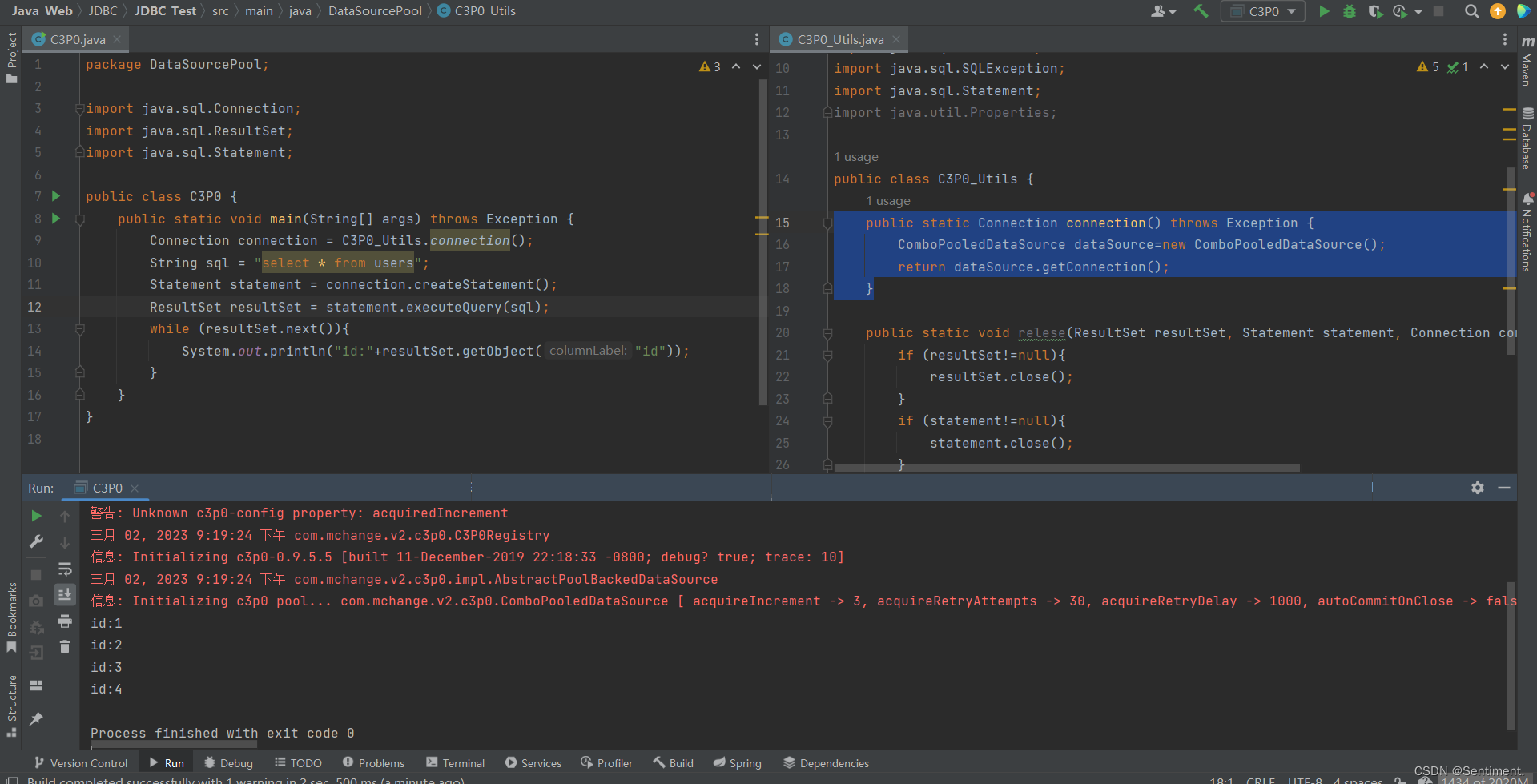前言
其实学Mybatis前就该学了,但是寻思目前主流框架都是用mybatis和mybatis-plus就没再去看,结果在代码审计中遇到了很多cms是使用jdbc的因此还是再学一下吧。
第一个JDBC程序
sql文件
INSERT INTO `users`(`id`, `NAME`, `PASSWORD`, `email`, `birthday`) VALUES (1, 'zhansan', '123456', 'zs@sina.com', '1980-12-04');
INSERT INTO `users`(`id`, `NAME`, `PASSWORD`, `email`, `birthday`) VALUES (2, 'lisi', '123456', 'lisi@sina.com', '1981-12-04');
INSERT INTO `users`(`id`, `NAME`, `PASSWORD`, `email`, `birthday`) VALUES (3, 'wangwu', '123456', 'wangwu@sina.com', '1979-12-04');
HelloJDBC
import java.sql.*;
public class HelloJDBC {
public static void main(String[] args) throws ClassNotFoundException, SQLException {
//1. 加载驱动
Class.forName("com.mysql.jdbc.Driver");
//2. 用户信息和url
String url = "jdbc:mysql://127.0.0.1:3306/jdbc?useUnicode=true&characterEncoding=utf8&useSSL=true";
String name = "root";
String password = "123456";
//3. 连接数据库 connection是数据库对象
Connection connection = DriverManager.getConnection(url, name, password);
//4. 执行sql的对象 statement是执行sql的对象
Statement statement = connection.createStatement();
//5. 用statement对象执行sql语句
String sql = "select * from users";
ResultSet resultSet = statement.executeQuery(sql);
while (resultSet.next()){
System.out.println("id:"+resultSet.getObject("id")+",name:"+resultSet.getObject("name")+",password:"+resultSet.getObject("password"));
System.out.println("=============================");
}
//6.释放资源
resultSet.close();
statement.close();
connection.close();
}
}
Statement对象
工具类
package utils;
import java.io.IOException;
import java.io.InputStream;
import java.sql.*;
import java.util.Properties;
public class JdbcUtils {
public static Connection connection() throws ClassNotFoundException, SQLException, IOException {
InputStream in = JdbcUtils.class.getClassLoader().getResourceAsStream("db.properties");
Properties properties = new Properties();
properties.load(in);
String driver = properties.getProperty("driver");
String url = properties.getProperty("url");
String username = properties.getProperty("username");
String password = properties.getProperty("password");
Class.forName(driver);
return DriverManager.getConnection(url,username,password);
}
public static void relese(ResultSet resultSet, Statement statement, Connection connection) throws SQLException {
if (resultSet!=null){
resultSet.close();
}
if (statement!=null){
statement.close();
}
if (connection!=null){
connection.close();
}
}
}
Demo
import utils.JdbcUtils;
import java.io.IOException;
import java.sql.Connection;
import java.sql.ResultSet;
import java.sql.SQLException;
import java.sql.Statement;
public class JdbcStatement {
public static void main(String[] args) throws Exception {
// query();
insert();
}
public static void query() throws SQLException, ClassNotFoundException, IOException{
Connection connection = JdbcUtils.connection();
String sql = "select * from users";
Statement statement = connection.createStatement();
ResultSet resultSet = statement.executeQuery(sql);
while(resultSet.next()){
System.out.println("id:"+resultSet.getObject("id"));
}
JdbcUtils.relese(resultSet,statement,connection);
}
public static void insert() throws Exception{
Connection connection = JdbcUtils.connection();
String sql = "insert into users values(4,'Sentiment',123456,'Sentiment@qq.com','1980-12-04')";
Statement statement = connection.createStatement();
int i = statement.executeUpdate(sql);
System.out.println(i);
JdbcUtils.relese(null,statement,connection);
}
}
查询用executeQuery(),增、删、改用executeUpdate()
PreparedStatement对象
用statement的话会有sql注入问题,因此可以用preparedstatement进行预处理来进行防御
主要是通过占位符来执行查询语句
public class JdbcPreparedStatement {
public static void main(String[] args) throws SQLException, IOException, ClassNotFoundException {
Connection connection = JdbcUtils.connection();
String sql = "insert into users values(?,?,?,null,null)";
PreparedStatement ps = connection.prepareStatement(sql);
ps.setInt(1,5);
ps.setString(2,"Sentiment");
ps.setInt(3,123456);
ps.execute();
}
}
操作事务
mybatis中学过,不过连含义都忘了。。。。
其实就是执行语句时要不都成功执行,一个不能执行则全部都不执行
主要就是关闭自动提交事务
connection.setAutoCommit(false); //开启事务
Demo
PreparedStatement ps = null;
Connection connection = null;
try {
connection = JdbcUtils.connection();
//关闭数烟库的自动提交,自动会开启事务connection
connection.setAutoCommit(false); //开启事务
String sql1 = "update users set name = 'Sentiment' where id=3";
ps = connection.prepareStatement(sql1);
ps.executeUpdate();
int x = 1 / 0;
String sql2 = "update users set name = 'Sentiment' where id=1";
ps = connection.prepareStatement(sql2);
ps.executeUpdate();
connection.commit();
System.out.println("Success!");
}catch (SQLException e){
connection.rollback(); //执行失败后,事务回滚
}finally {
JdbcUtils.relese(null,ps,connection);
}
}
数据库连接池
在上述工具类中,是通过以下方法来获取配置文件参数,并连接连接池
String driver = properties.getProperty("driver");
String url = properties.getProperty("url");
String username = properties.getProperty("username");
String password = properties.getProperty("password");
Class.forName(driver);
return DriverManager.getConnection(url,username,password);
而我们可以用开源的数据库连接池如DBCP、C3P0、Druid等
使用了这些数据库连接池之后,我们在项目开发中就不需要编写连接数据库的代码了!
DBCP
<dependency>
<groupId>commons-dbcp</groupId>
<artifactId>commons-dbcp</artifactId>
<version>1.4</version>
</dependency>
<dependency>
<groupId>commons-pool</groupId>
<artifactId>commons-pool</artifactId>
<version>1.5.4</version>
</dependency>
配置文件
driverClassName=com.mysql.jdbc.Driver
url=jdbc:mysql://127.0.0.1:3306/jdbc?useUnicode=true&characterEncoding=utf8&useSSL=true
username=root
password=123456
#<!-- 初始化连接 -->
initialSize=10
#最大连接数量
maxActive=50
#<!-- 最大空闲连接 -->
maxIdle=20
#<!-- 最小空闲连接 -->
minIdle=5
#<!-- 超时等待时间以毫秒为单位 6000毫秒/1000等于60秒 -->
maxWait=60000
#JDBC驱动建立连接时附带的连接属性属性的格式必须为这样:【属性名=property;】
#注意:"user" 与 "password" 两个属性会被明确地传递,因此这里不需要包含他们。
connectionProperties=useUnicode=true;characterEncoding=utf8
#指定由连接池所创建的连接的自动提交(auto-commit)状态。
defaultAutoCommit=true
#driver default 指定由连接池所创建的连接的只读(read-only)状态。
#如果没有设置该值,则“setReadOnly”方法将不被调用。(某些驱动并不支持只读模式,如:Informix)
defaultReadOnly=true
#driver default 指定由连接池所创建的连接的事务级别(TransactionIsolation)。
#可用值为下列之一:(详情可见javadoc。)NONE,READ_UNCOMMITTED, READ_COMMITTED, REPEATABLE_READ, SERIALIZABLE
defaultTransactionIsolation=READ_COMMITTED
Demo
使用DBCP后,utils就可以简化为:
public static Connection connection() throws Exception {
InputStream in = DBCP_Utils.class.getClassLoader().getResourceAsStream("dbcp.properties");
Properties properties = new Properties();
properties.load(in);
//创建数据源
DataSource dataSource = BasicDataSourceFactory.createDataSource(properties);
return dataSource.getConnection();
}
读取配置文件,交给数据源即可
C3P0
这个更简单
<dependency>
<groupId>com.mchange</groupId>
<artifactId>c3p0</artifactId>
<version>0.9.5.5</version>
</dependency>
<dependency>
<groupId>com.mchange</groupId>
<artifactId>mchange-commons-java</artifactId>
<version>0.2.19</version>
</dependency>
配置文件
这里设置了两个数据源:
<default-config>:默认值创建数据源时不需要形参,ComboPooledDataSource ds=new ComboPooledDataSource();
<named-config name="MySQL">: 非默认要指定数据源,ComboPooledDataSource ds=new ComboPooledDataSource(“MySQL”);
<?xml version="1.0" encoding="UTF-8"?>
<c3p0-config>
<!--
c3p0的缺省(默认)配置
如果在代码中"ComboPooledDataSource ds=new ComboPooledDataSource();"这样写就表示使用的是c3p0的缺省(默认)
-->
<default-config>
<property name="driverClass">com.mysql.jdbc.Driver</property>
<property name="jdbcUrl">jdbc:mysql://127.0.0.1:3306/jdbc?useUnicode=true&characterEncoding=utf8&useSSL=true</property>
<property name="user">root</property>
<property name="password">123456</property>
<property name="acquiredIncrement">5</property>
<property name="initialPoolSize">10</property>
<property name="minPoolSize">5</property>
<property name="maxPoolSize">20</property>
</default-config>
<!--
c3p0的命名配置
如果在代码中"ComboPooledDataSource ds=new ComboPooledDataSource("MySQL");"这样写就表示使用的是mysql的缺省(默认)
-->
<named-config name="MySQL">
<property name="driverClass">com.mysql.jdbc.Driver</property>
<property name="jdbcUrl">jdbc:mysql://127.0.0.1:3306/jdbc?useUnicode=true&characterEncoding=utf8&useSSL=true</property>
<property name="user">root</property>
<property name="password">123456</property>
<property name="acquiredIncrement">5</property>
<property name="initialPoolSize">10</property>
<property name="minPoolSize">5</property>
<property name="maxPoolSize">20</property>
</named-config>
</c3p0-config>
Demo
xml文件默认能读取到
public static Connection connection() throws Exception {
ComboPooledDataSource dataSource=new ComboPooledDataSource();
return dataSource.getConnection();
}
自带日志























 1426
1426











 被折叠的 条评论
为什么被折叠?
被折叠的 条评论
为什么被折叠?








